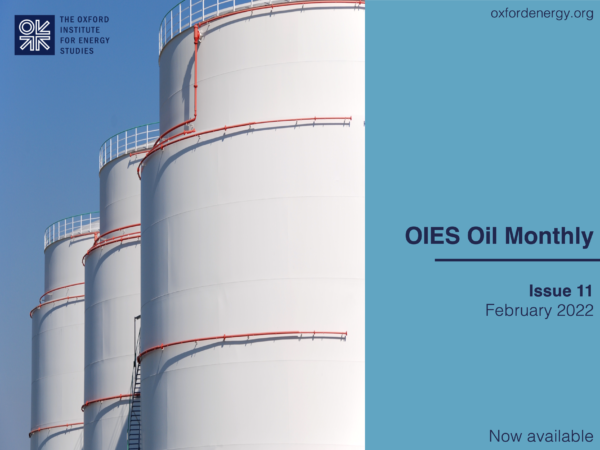OIES Oil Monthly – Issue 11
The new issue of OIES Oil Monthly, including our latest short-term oil market outlook to 2023, is now available.
Our reference forecast for Brent is upgraded to $85.2/b in 2022 and $82.1/b in 2023. The major uplifts this month mainly reflect the muted impact of Omicron on demand that outperformed our previous growth expectations in Q4 2021, resulting in tight stocks position heading to 2022 and aggravating near-term geopolitical pressures largely due to the escalating Russia-Ukraine tensions. As such, the balance of risks has shifted to the upside with near-term geopolitical pressures pushing prices to the $85/b and $100/b range, before prices start retreating in H2 2022 to the low-$80s. Beyond the near-term, elevated supply risks related to the OPEC+ tapering process and concerns over the size of available spare capacity provide support to prices and shadow downside demand risks on growth, inflation and supply bottleneck concerns.
Global oil demand growth is upgraded to 5.5 mb/d in 2021 and is little changed to 3.4 mb/d in 2022 and 2.1 mb/d in 2023. The limited impact of Omicron on mobility and economic activity, aggravated by supportive data of oil switching, contributed to demand outperforming expectations largely in OECD and we now project global demand in 2022 to average 99.8 mb/d versus 99.5 mb/d in 2019. Growth concerns, however, driven by high inflation and ongoing supply bottlenecks, remain elevated, maintaining demand growth expectations confined to the 3 mb/d and 4 mb/d range. In terms of products, jet fuel remains a wildcard and it is currently seen persisting 8 per cent lower year-end.
Global supply growth is lowered to 5.5 mb/d in 2022 and is slightly upgraded to 2 mb/d in 2023. The OPEC+ tapering, US shale response and Iran return continue to dictate the outlook in 2022, as the size of available spare capacity and drilling activity to replenish lost production come into focus beyond the near-term. As the OPEC+ deal enters its final stretch uncertainty rises, with producers projected to struggle to return more than 2 mb/d in 2022 compared to the headline 3.76 mb/d. Moreover, as OPEC+ starts producing closer to its maximum capacity the spare capacity cushion diminishes and in conjunction with multiyear low stocks, they are seen raising geopolitical risk premium and supporting prices. Non-OPEC supply growth is little changed to 1.9 mb/d in 2022, with the pace of recovery seen accelerating driven by the US, albeit overall production is expected to remain 0.34 mb/d below 2019 levels.
The market surpluses in both 2022 and 2023 are lowered to 1 mb/d and 0.9 mb/d, respectively. Heading to 2022, the market faces a tight stocks position amid declining spare capacity, which are not expected to ease, exerting significant pressure on prices.
